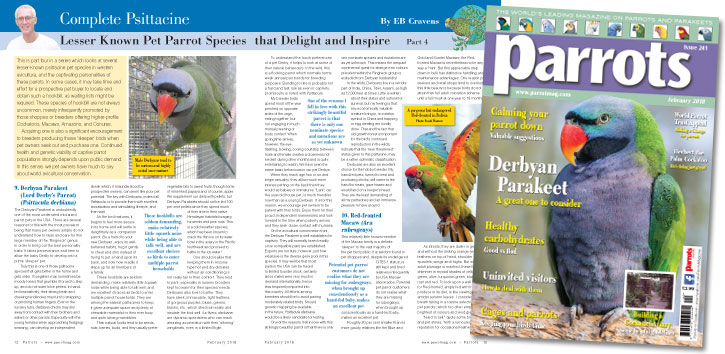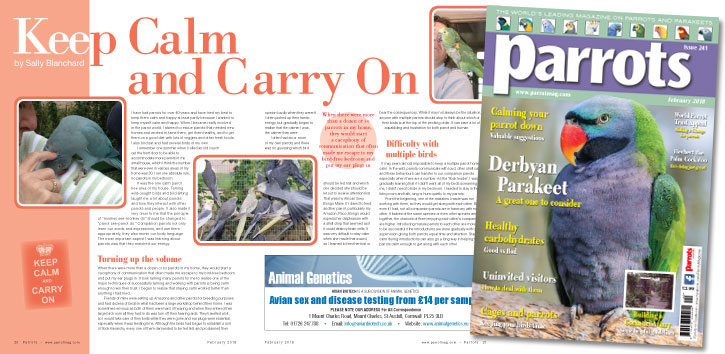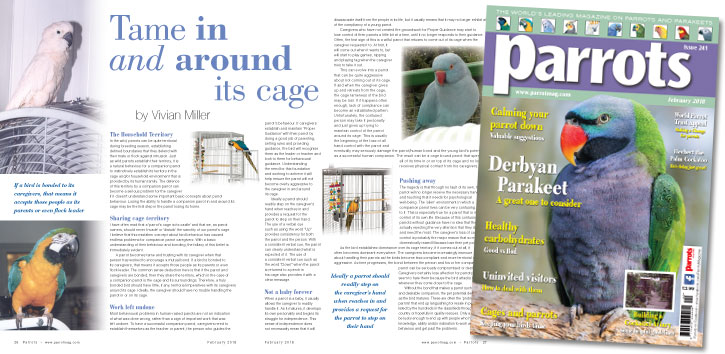
Complete Psittacine by Eb Cravens
This is part four in a series which looks at several lesser-known psittacine pet species in western aviculture, and the captivating personalities of these parrots. In some cases, it may take time and effort for a prospective pet buyer to locate and obtain such a hookbill, as waiting lists might be required. These species of hookbill are not always uncommon, merely infrequently promoted by those shoppes or breeders offering higher-profile Cockatoos, Macaws, Amazons, and Conures.
Acquiring one is also a significant encouragement to breeders producing these ‘sleeper’ birds when pet owners seek out and purchase one. Continued health and genetic viability of captive parrot populations strongly depends upon public demand. In this sense, we pet owners have much to say about world avicultural conservation.
The Derbyan Parakeet is undoubtedly one of the most underrated mid-sized parrot pets in the USA. There are several reasons for this with the most prevalent being that many pet owners simply do not understand how to raise and care for this large member of the ‘Ringneck’ genus in order to bring out the best personality traits. It takes perseverance and time to allow the baby Derby to develop into a prime ‘sleeper’ pet.
Truly this is one of those psittacine species that gets better in the home as it gets older. Youngsters may sometimes be moody loners that grumble if forced to step up, and do not want to be petted. In hand-fed insensitively, their strong beak and chewing tendencies may turn to snapping or pinching human fingers. Even in the nursery tubs, derbiana chicks may shy away from contact with their brothers and sisters or other parrots. Especially with the young females when approaching fledging/weaning, can develop an independent streak which, if misunderstood by prospective owners, can seem like poor pet potential. The key with Derbyans, indeed all Psittacula, is to provide them with excellent socialisation and stimulating lifestyle, and then wait.
Buy Now!

The Holistic Parrot by Leslie Moran
Last month we began discussing how the foods we eat, and those we feed our birds, are processed and how these processing methods affect nutrients and health. We established three categories, foods that are highly processed, those that are wholesome processed and whole foods. Another way to look at these three processing categories is to explore the difference between ‘good carbs’ verses ‘bad carbs’.
‘Good carbs’ defined: Why are foods such as fresh fruits, raw or steamed vegetables, legumes, properly grown sprouts and whole cooked grains so healthy for us and our birds? These wholesome processed and whole foods share several qualities in common.
Buy Now!

By Sally Blanchard
I have had parrots for over 40 years and have tried my best to keep them calm and happy at least partly because I wanted to keep myself calm and happy. When I became really involved in the parrot world, I started to rescue parrots that needed new homes and worked to tame them, get them healthy, and to get them on a good diet with lots of veggies and other fresh foods. I also bird sat and had several birds of my own.
I remember one summer when I rolled an old couch out the front door to be able to accommodate more parrots in my small house, which I think the number that were ever in various areas of my home was 30. I set one absolute rule, no parrots in my bedroom.
It was the one calm parrot free area of my house. Taming wild-caught birds and bird sitting taught me a lot about parrots and how they interact with other parrots and people. It also made it very clear to me that the principle of “monkey see-monkey do” should be changed to “parrot see-parrot do.” Companion parrots not only learn our words and expressions, and use them appropriately, they also mimic our body language. The most important aspect I was learning about parrots was that they matched our energy.
Buy Now!

By Vivian Miller
In the wild, parrots can be quite territorial during breeding season, establishing defined boundaries that they defend with their mate or flock against intrusion. Just as wild parrots establish their territory, it is a natural behaviour for a companion parrot to instinctively establish its territory in the cage and/or household environment that is provided by its human family. The defence of this territory by a companion parrot can become a serious problem for the caregiver if it doesn't understand some important basic concepts about parrot behaviour. Losing the ability to handle a companion parrot in and around its cage may be the first step in the parrot losing its home.
I have often read that a 'parrot’s cage is its castle' and that we, as parrot owners, should never 'invade' or 'disturb' the sanctity of our parrot’s cage.
I believe that this mistaken concept about bird behaviour has caused endless problems for companion parrot caregivers. With a basic understanding of their behaviour and bonding, the fallacy of this belief is immediately evident.
A parrot becomes tame and trusting with its caregiver when that person has worked to encourage a mutual bond. If a bird is bonded to its caregivers, that means it accepts those people as its parents or even flock leader. The common sense deduction here is that if the parrot and caregivers are bonded, then they share the territory, which in the case of a companion parrot is the cage and its surroundings. Therefore, a truly bonded bird should have little, if any, territorial imperatives with its caregivers around its cage. Ideally, the caregiver should have no trouble handling the parrot in or on its cage.
Buy Now!




